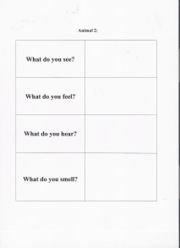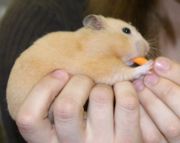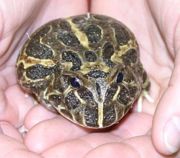Frogs vs. Hamsters: Using Your Senses
| Instant wiki maker | Making handouts | Editing tips |
Contents
Biology In Elementary Schools is a Saint Michael's College student project from a course that ran between 2007 and 2010 and fully described in this book chapter. The student-created resources have been preserved here for posterity. Link under 'toolbox' for printer-friendly versions of the exercises. Click on handouts to print full resolution versions. Please see Wikieducator's disclaimer, our safety statement, and the Creative Commons licensing in English and in legalese.
Student worthiness
Tried and trusted
Primary biological content area covered
Students will use their senses (with the exception of taste), to make observations in order to compare two different animals: a frog and a hamster. Classification is also touched upon slightly.
Materials
- 1 frog
- 1 hamster
- Personal observation sheets (1 per student)
- Big poster paper
- Markers
- Pencils
- Hand lenses
- Diagrams and pictures of the type of frog and hamster used in the activity may be good to have on hand.
- Suitable containers to hold the animals
Handouts
Students will be given their own observation sheet to record the characteristics of the animals.
Description of activity
Students will use their senses to determine the similarities and differences between hamsters and frogs. Students will use sight, hearing, touch, and smell.
Lesson plan
- The lesson begins by talking about the different senses. Students will discuss sight, touch, smell, taste, and hearing. Students will then determine which body parts are used with each of the senses.
- There will be a hamster and a frog set up in their own habitats. Students will break into two groups; half of the students will begin working with the hamster, the other group will begin working with the frog.
- Students will use four of their senses to determine different characteristics of the animals.
- Students will record their observations (including pictures of characteristics they observe) on their handout.
- After the two groups finish with their animal, they will switch.
- Students will again use their senses to observe the characteristics of the second animal. After all of the students have been able to work with both animals, the groups will be brought back together.
- As one group, students will share all of the observations that they made about the frog and the hamster. Results from the observations will be written on a large poster sheet by the teacher. The results from all of the groups will be kept on the poster sheet.
- After all of the characteristics are recorded, students will compare the two to see how they are similar, and how they are different.
- Students will then be shown diagrams and/or pictures of hamsters and frogs in order to determine the type of hamster and frog that were used in the activity.
Learned from Experience: Positives and Pitfalls
- Some students may be afraid of working with either the hamster or the frog; teachers should be there to assist and reassure.
- There may be allergies to one or both of the animals. Teachers should be sure they know of these prior to bringing in the animals.
- Students may be overly rough with the animals.
- Teachers must pay careful attention to ensure that the animals are handled carefully.
- Try to conduct this activity in as quiet of an environment as possible; loud noises may be very frightening to the small animals.
- Tell students not to put their fingers near the mouth of the hamster...she may think that it is a treat and bite the finger.
- You may want to have more than one of each animal available to switch out 1/2 way through the activity. Using the same animal over and over again may be extremely tiresome to the small animals (especially the hamster who would ordinarily be sleeping during the day).
- If possible, allow students the opportunity to look at other kinds of frogs.
- Show students the hamster "trick." The hamster will store the food in its mouth, then hide it for future use. Students enjoyed watching the hamster store the food in its mouth.
-Overall, our experience was extremely positive. All of our students were very interested in learning about the animals by using their senses.
Math connections
As part of their observations, students will count appendages and other body parts that the animals have. This whole activity focuses on comparisons, an important mathematical concept.
Literature connections
Teachers may want to read the book, Frogs by Gail Gibbons, or My Hamster and Me by Peter Hollimann before beginning the lesson.
Teachers may also wish to include the book, "Frog Heaven" Ecology of a Vernal Pool
Wechsler, Doug. 2006. Frog Heaven. Boyds Mills Press.
This book describes the frog as a fisher and also as a musician. These job titles personify the animal, allowing the student to identify with it on a personal level. The book also describes in detail the habitat of the frog. It provides interesting descriptions of how some salamanders are active, even when the pond they live in is iced over for the winter, and also how the wood frog is an explosive breeder.
These are all ideas that will get the children thinking, and to harness their creativity and also to continue the thinking process the teacher may have the child write a short story about life as a frog, picking the topic discussed in the book that most interests them. They will organize their thoughts before hand. They will respond to the facts by explaining what it is like to be a frog. This activity will use a combination of mechanical skills and a complex overt response to the piece of literature. It will also allow the student to have fun and explore their imagination.
Connections to educational standards
7.13 Students understand the characteristics of organisms, see patterns of similarity and differences among living organisms, understand the role of evolution, and recognize the interdependence of all systems that support life.
Next steps
- Students can use their senses to determine the similarities and differences between other types of animals.
- Students can look at two organisms of the same species and find differences between them in order to further their understanding of classification.
- Students can investigate the animals further; they can begin studying other things about the animals that they are unable to discover using solely their senses.
Citations and links
Vermont State Grade Expectations can be found at the State of Vermont Department of Education website. [1]




